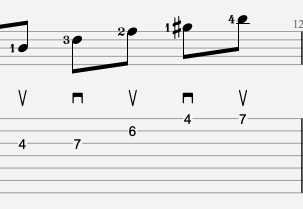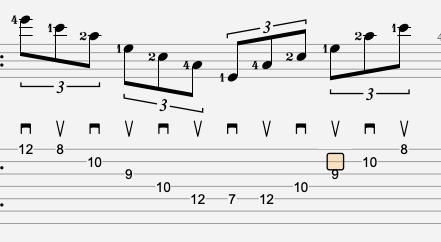Yeah I’m not sure it’s the most efficient way to develop evenness, it helped me out, but to your point it’s definitely much more important to figure out a compound movement that is comfortable and affords as much control as possible, especially descending, and that means something that works with however you decide to anchor. I think the finger involvement is usually part of that, maybe not necessarily.
As for the bar shapes, I treat the two almost as different techniques. I try to only use barring when either the speed is too fast for me to fret everything or if it’s such a demanding section that doing so would fatigue my hand. I agree that barring is important, and I think it’s some quirk of Jason Richardson’s that he couldn’t do so cleanly, maybe he lacks backwards flexibility in his DIP/fingertip joint or something that makes it more difficult.
One other point as far as fretting hand efficiency though, which I did get from JR is using efficient fingerings, which I was not doing -
for example 1) Diminished 3 string sweeps, I kept using pinky twice in the movement and getting tired - he uses ring finger on the G string - felt awkward at first but is now way more comfortable:

For example 2), 5 string, 2nd inversion minor shape

I used to play it with fingering 4-1-2-3-2-4-1 using my ring finger and I actually got it pretty fast and even but it caused way more fatigue. It’s probably universally better to opt to use index and middle whenever possible for any shape even if it requires a small jump or wrist adjustment, for efficiency sake when sweeping. But that could be a weird quirk of my playing. I remember reading that it’s super hard to alternated middle and ring and ring and pinky and I definitely took it as a challenge as a teenager because I’m stubborn.










